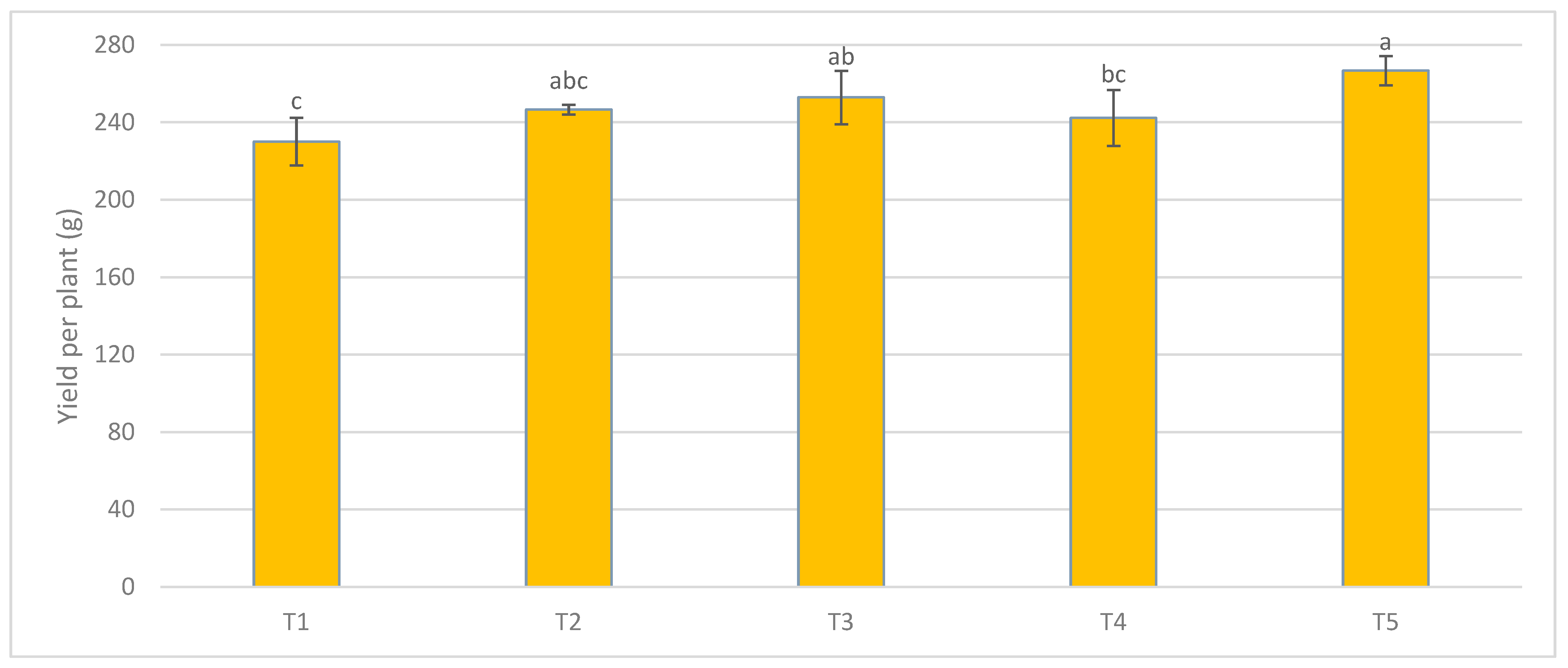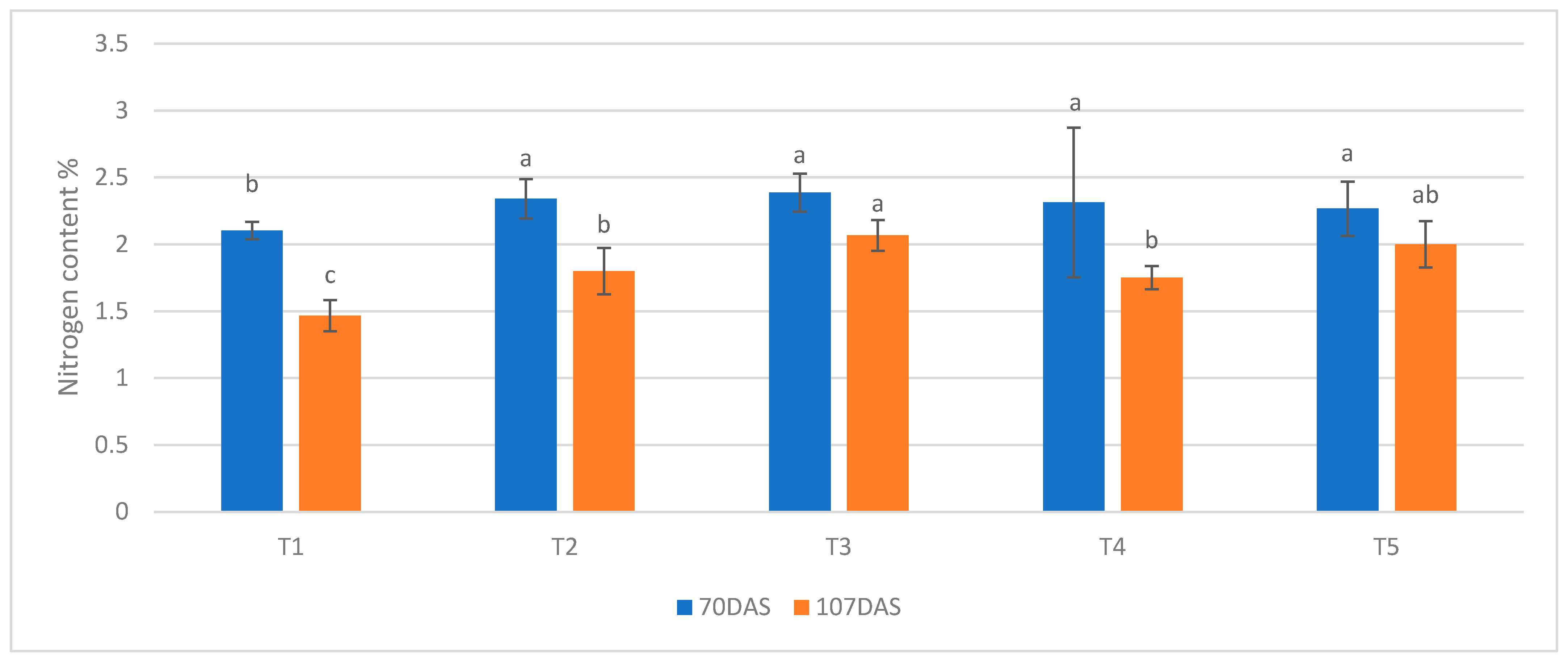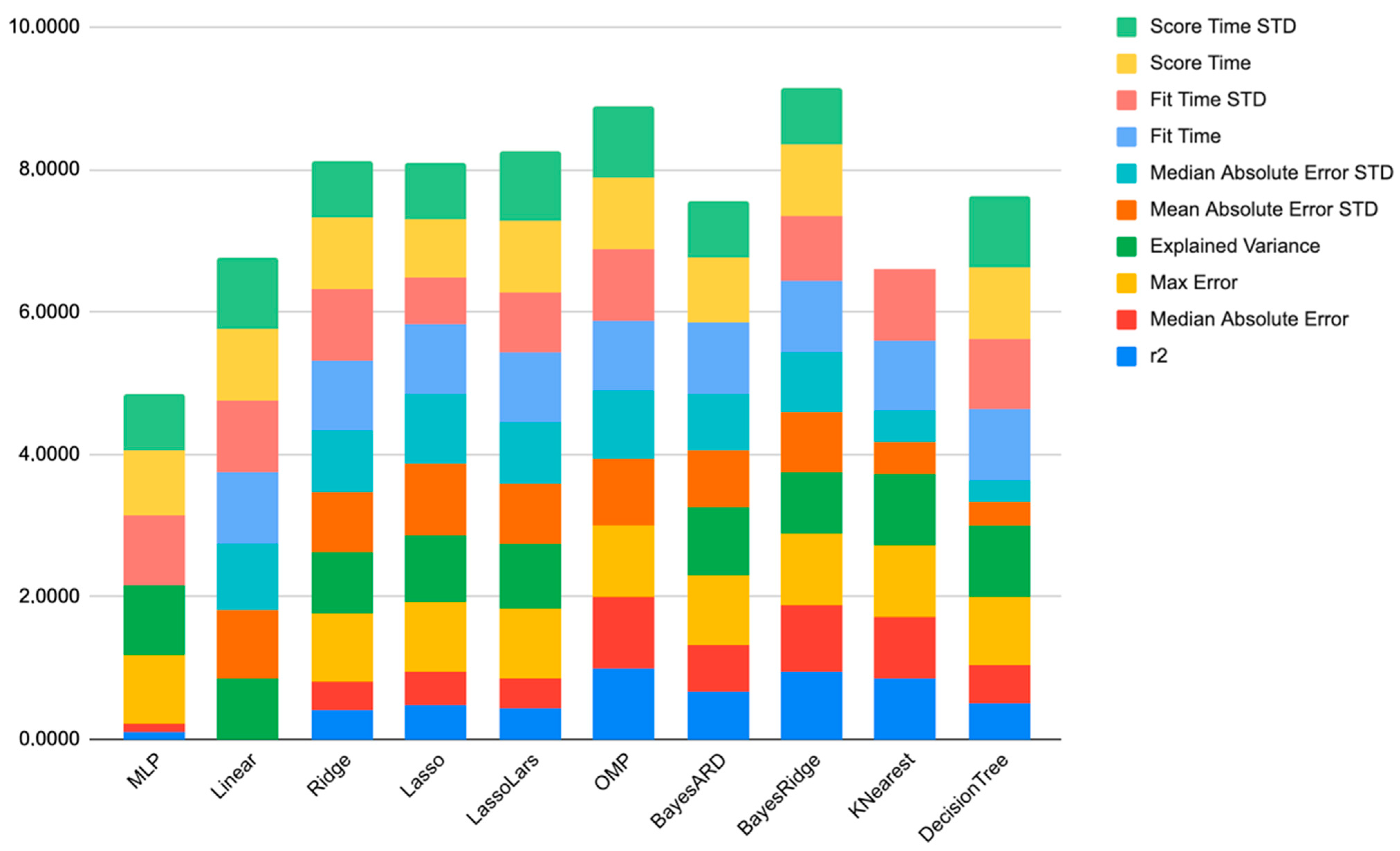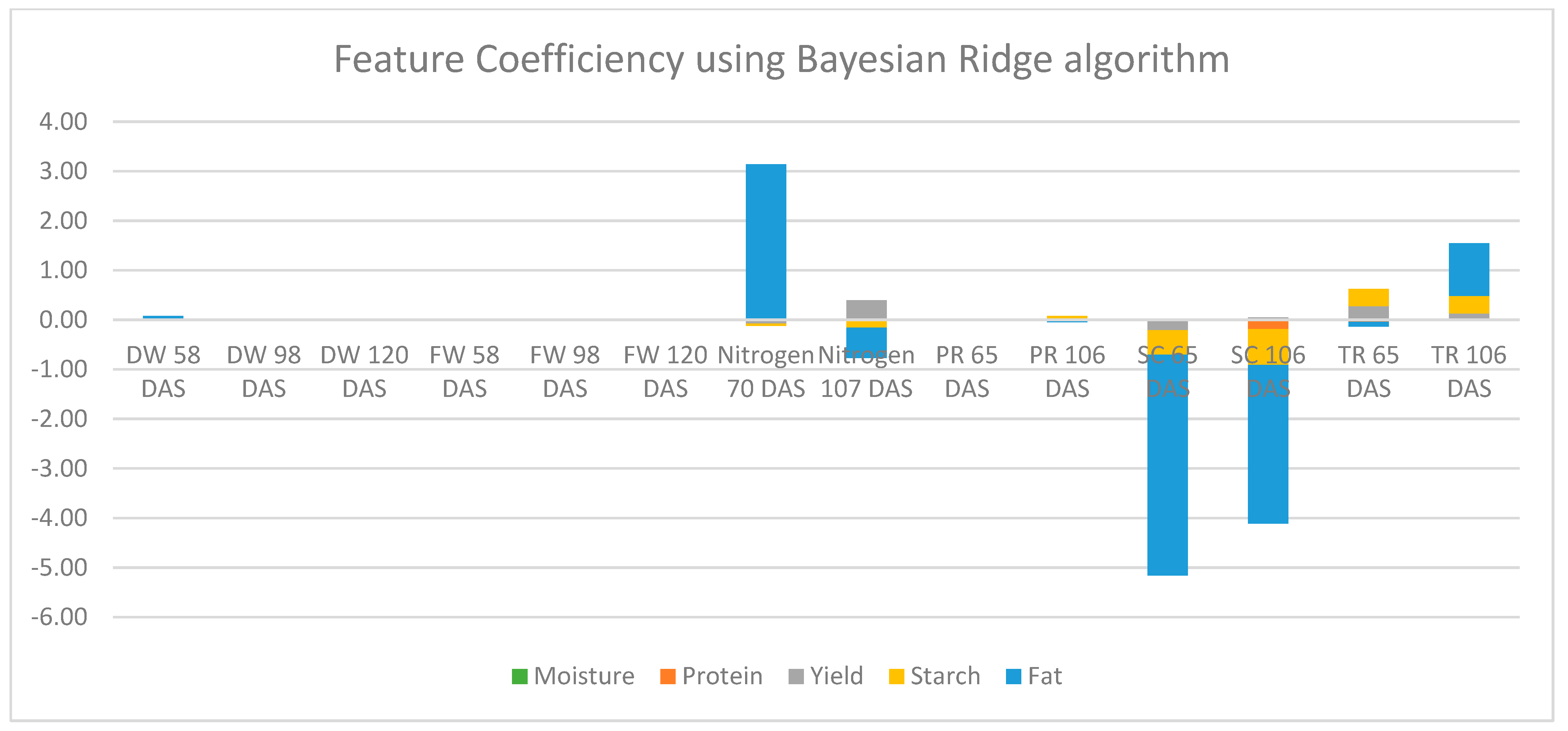Comparative Evaluation of Mineral and Organo-Mineral Nitrogen Fertilization and the Role of Amino Acids as Plant Growth Promoters in Maize Cultivation
Abstract
1. Introduction
2. Materials and Methods
2.1. Experimental Site and Design
2.2. Measurements
2.3. Quality Characteristics of Harvested Corn Grains
2.4. Statistical Analysis
3. Results
3.1. Plant Growth
3.2. Physiology Measurements
3.3. Yield
3.4. Grain Quality Measurements
3.5. Plant Tissue Analysis
3.6. Feature Coefficiency Using Machine Learning Models
4. Discussion
5. Conclusions
Author Contributions
Funding
Data Availability Statement
Acknowledgments
Conflicts of Interest
References
- Webber, H.; Ewert, F.; Olesen, J.E.; Müller, C.; Fronzek, S.; Ruane, A.C.; Bourgault, M.; Martre, P.; Ababaei, B.; Bindi, M.; et al. Diverging Importance of Drought Stress for Maize and Winter Wheat in Europe. Nat. Commun. 2018, 9, 4249. [Google Scholar] [CrossRef] [PubMed]
- Ion, V.; Basa, A.G.; Temocico, G.; Epure, L.I. Maize Biomass Yield at Different Preceding Crops, Row Spacing and Nitrogen Conditions. In Proceedings of the 17th International Multidisciplinary Scientific GeoConference SGEM2017, Vienna, Austria, 27–29 November 2017; Volume 17, pp. 399–406. [Google Scholar]
- Xu, G.; Fan, X.; Miller, A.J. Plant Nitrogen Assimilation and Use Efficiency. Annu. Rev. Plant Biol. 2012, 63, 153–182. [Google Scholar] [CrossRef] [PubMed]
- Zucareli, C.; Piazzoli, D.; Sapucay, M.; Prando, A.; Júnior, J. Densidade de plantas e adubação nitrogenada em cobertura no desenvolvimento e desempenho produtivo do milho. Rev. Bras. Milho E Sorgo 2019, 18, 178–191. [Google Scholar] [CrossRef]
- Janzen, H.H.; Beauchemin, K.A.; Bruinsma, Y.; Campbell, C.A.; Desjardins, R.L.; Ellert, B.H.; Smith, E.G. The Fate of Nitrogen in Agroecosystems: An Illustration Using Canadian Estimates. Nutr. Cycl. Agroecosystems 2003, 67, 85–102. [Google Scholar] [CrossRef]
- Powlson, D.S.; Gregory, P.J.; Whalley, W.R.; Quinton, J.N.; Hopkins, D.W.; Whitmore, A.P.; Hirsch, P.R.; Goulding, K.W.T. Soil Management in Relation to Sustainable Agriculture and Ecosystem Services. Food Policy 2011, 36, S72–S87. [Google Scholar] [CrossRef]
- Quan, Z.; Liu, X.-A.; Liu, D. Research progress on soil soluble organic nitrogen. Chin. J. Appl. Ecol. 2022, 33, 277–288. [Google Scholar] [CrossRef]
- Jones, D.L.; Healey, J.R.; Willett, V.B.; Farrar, J.F.; Hodge, A. Dissolved Organic Nitrogen Uptake by Plants—An Important N Uptake Pathway? Soil Biol. Biochem. 2005, 37, 413–423. [Google Scholar] [CrossRef]
- Bilalis, D.; Sidiras, N.; Kakabouki, I.; Efthimiadou, A.; Papatheohari, Y.; Thomopoulos, P. Effects of Organic Fertilization on Maize/Legume Intercrop in a Clay Loam Soil and Mediterranean Climate—Can the Land Equivalent Ratio (LER) Index Be Used for Root Development? J. Food Agric. Environ. 2005, 3, 117. [Google Scholar]
- Katsenios, N.; Andreou, V.; Sparangis, P.; Djordjevic, N.; Giannoglou, M.; Chanioti, S.; Stergiou, P.; Xanthou, M.-Z.; Kakabouki, I.; Vlachakis, D.; et al. Evaluation of Plant Growth Promoting Bacteria Strains on Growth, Yield and Quality of Industrial Tomato. Microorganisms 2021, 9, 2099. [Google Scholar] [CrossRef]
- Rashid, N.; Wahid, A.; Ibrar, D.; Irshad, S.; Hasnain, Z.; Al-Hashimi, A.; Elshikh, M.S.; Jacobsen, S.-E.; Khan, S. Application of Natural and Synthetic Growth Promoters Improves the Productivity and Quality of Quinoa Crop through Enhanced Photosynthetic and Antioxidant Activities. Plant Physiol. Biochem. 2022, 182, 1–10. [Google Scholar] [CrossRef]
- Sadak, M.S.; Abdelhamid, M.T.; Schmidhalter, U. Effect of Foliar Application of Aminoacids on Plant Yield and Some Physiological Parameters in Bean Plants Irrigated with Seawater. Acta Biol. Colomb. 2015, 20, 141–152. [Google Scholar] [CrossRef]
- Rai, V.K. Role of Amino Acids in Plant Responses to Stresses. Biol. Plant. 2002, 45, 481–487. [Google Scholar] [CrossRef]
- Petrozza, A.; Santaniello, A.; Summerer, S.; Di Tommaso, G.; Di Tommaso, D.; Paparelli, E.; Piaggesi, A.; Perata, P.; Cellini, F. Physiological Responses to Megafol® Treatments in Tomato Plants under Drought Stress: A Phenomic and Molecular Approach. Sci. Hortic. 2014, 174, 185–192. [Google Scholar] [CrossRef]
- Suja, S.; Anusuya, N. Influence of Paclobutrazol (PP333) and Sridiamin (Human Hair-Derived Aminoacid Mixture) on Growth and Quality of Tomato PKM-1. In IOP Conference Series: Earth and Environmental Science; IOP Publishing: Bristol, UK, 2018; Volume 131. [Google Scholar]
- Ahmad, R.; Khalid, A.; Arshad, M.; Zahir, Z.A.; Mahmood, T. Effect of Compost Enriched with N and L-Tryptophan on Soil and Maize. Agron. Sustain. Dev. 2008, 28, 299–305. [Google Scholar] [CrossRef]
- Efthimiadou, A.; Bilalis, D.; Karkanis, A.; Froud-Williams, B. Combined Organic/Inorganic Fertilization Enhance Soil Quality and Increased Yield, Photosynthesis and Sustainability of Sweet Maize Crop. Aust. J. Crop Sci. 2010, 4, 722–729. [Google Scholar] [CrossRef]
- Tartoura, S.; El-Gamily, E.E.; El-Shall, Z.S.; Elsharqawy, M.M.S. Effect of Organo-Chemical Fertilizers Mixtures under the Condition of Irrigation Intervals with Magnetized Water on Yield and Its Components of Jerusalem Artichoke. J. Plant Prod. 2020, 11, 1443–1452. [Google Scholar] [CrossRef]
- Ekinci, M.; Atamanalp, M.; Turan, M.; Alak, G.; Kul, R.; Kitir, N.; Yildirim, E. Integrated Use of Nitrogen Fertilizer and Fish Manure: Effects on the Growth and Chemical Composition of Spinach. Commun. Soil Sci. Plant Anal. 2019, 50, 1580–1590. [Google Scholar] [CrossRef]
- El-Tarabily, K.A.; Nassar, A.H.; Hardy, G.E.S.J.; Sivasithamparam, K. Fish Emulsion as a Food Base for Rhizobacteria Promoting Growth of Radish (Raphanus sativus L. var. sativus) in a Sandy Soil. Plant Soil 2003, 252, 397–411. [Google Scholar] [CrossRef]
- Lindsey, L.; Shange, R.; Ankumah, R.O.; Mortley, D.G.; Karki, S. Hydrolyzed Organic Fish Fertilizer and Poultry Litter Influence Yield and Rhizosphere Ecology of Sweetpotato. HortScience 2019, 54, 941–947. [Google Scholar] [CrossRef]
- Ahmed, Z.F.R.; Alnuaimi, A.K.H.; Askri, A.; Tzortzakis, N. Evaluation of Lettuce (Lactuca sativa L.) Production under Hydroponic System: Nutrient Solution Derived from Fish Waste vs. Inorganic Nutrient Solution. Horticulturae 2021, 7, 292. [Google Scholar] [CrossRef]
- Shaik, A.; Singh, H.; Singh, S.; Montague, T.; Sanchez, J. Liquid Organic Fertilizer Effects on Growth and Biomass of Lettuce Grown in a Soilless Production System. HortScience 2022, 57, 447–452. [Google Scholar] [CrossRef]
- Bouyoucos, G.J. Hydrometer Method Improved for Making Particle Size Analyses of Soils. Agron. J. 1962, 54, 464–465. [Google Scholar] [CrossRef]
- ISO 11265:1994; Soil Quality—Determination of the Specific Electrical Conductivity. International Standard Organisation (ISO): Geneva, Switzerland, 1994.
- ISO 14235:1998; Soil Quality—Determination of Organic Carbon by Sulfochromic Oxidation. International Standard Organisation (ISO): Geneva, Switzerland, 1998.
- ISO 11261:1995; Soil Quality—Determination of Total Nitrogen—Modified Kjeldahl Method. International Standard Organisation (ISO): Geneva, Switzerland,, 1995.
- ISO 11260:1994; Soil Quality—Determination of Effective Cation Exchange Capacity and Base Saturation Level Using Barium Chloride Solution. International Standard Organisation (ISO): Geneva, Switzerland, 1994.
- ISO 11263:1994; Soil Quality—Determination of Phosphorus—Spectrometric Determination of Phosphorus Soluble in Sodium Hydrogen Carbonate Solution. International Standard Organisation (ISO): Geneva, Switzerland, 1994.
- ISO 14870:2001; Soil Quality—Extraction of Trace Elements by Buffered DTPA Solution. International Standard Organisation (ISO): Geneva, Switzerland, 2001.
- Bingham, F.T. Boron. In Methods of Soil Analysis; John Wiley & Sons, Ltd.: New York, NY, USA, 1983; pp. 431–447. ISBN 978-0-89118-977-0. [Google Scholar]
- Calvo, P.; Nelson, L.; Kloepper, J.W. Agricultural Uses of Plant Biostimulants. Plant Soil 2014, 383, 3–41. [Google Scholar] [CrossRef]
- Mustafa, A.; Imran, M.; Ashraf, M.; Mahmood, K. Perspectives of Using L-Tryptophan for Improving Productivity of Agricultural Crops: A Review. Pedosphere 2018, 28, 16–34. [Google Scholar] [CrossRef]
- Yakhin, O.I.; Lubyanov, A.A.; Yakhin, I.A.; Brown, P.H. Biostimulants in Plant Science: A Global Perspective. Front. Plant Sci. 2017, 7, 2049. [Google Scholar] [CrossRef]
- Gondek, K.; Mierzwa-Hersztek, M. Effect of Soil-Applied L-Tryptophan on the Amount of Biomass and Nitrogen and Sulfur Utilization by Maize. Agronomy 2021, 11, 2582. [Google Scholar] [CrossRef]
- Popko, M.; Michalak, I.; Wilk, R.; Gramza, M.; Chojnacka, K.; Górecki, H. Effect of the New Plant Growth Biostimulants Based on Amino Acids on Yield and Grain Quality of Winter Wheat. Molecules 2018, 23, 470. [Google Scholar] [CrossRef]
- Shekari, G.; Javanmardi, J. Effects of Foliar Application Pure Amino Acid and Amino Acid Containing Fertilizer on Broccoli (Brassica oleracea L. var. italica) Transplants. Adv. Crop Sci. Technol. 2017, 5, 1–4. [Google Scholar] [CrossRef]
- Khan, S.; Yu, H.; Li, Q.; Gao, Y.; Sallam, B.N.; Wang, H.; Liu, P.; Jiang, W. Exogenous Application of Amino Acids Improves the Growth and Yield of Lettuce by Enhancing Photosynthetic Assimilation and Nutrient Availability. Agronomy 2019, 9, 266. [Google Scholar] [CrossRef]
- Hammad, S.A.R.; Ali, O.A.M. Physiological and Biochemical Studies on Drought Tolerance of Wheat Plants by Application of Amino Acids and Yeast Extract. Ann. Agric. Sci. 2014, 59, 133–145. [Google Scholar] [CrossRef]
- Gioseffi, E.; de Neergaard, A.; Schjoerring, J.K. Interactions between Uptake of Amino Acids and Inorganic Nitrogen in Wheat Plants. Biogeosciences 2012, 9, 1509–1518. [Google Scholar] [CrossRef]
- Najafi-Zangeneh, S.; Shams-Gharneh, N.; Arjomandi-Nezhad, A.; Hashemkhani Zolfani, S. An Improved Machine Learning-Based Employees Attrition Prediction Framework with Emphasis on Feature Selection. Mathematics 2021, 9, 1226. [Google Scholar] [CrossRef]
- Albadrani, A.; Alghayadh, F.; Zohdy, M.A.; Aloufi, E.; Olawoyin, R. Performance and Predicting of Inbound Logistics Processes Using Machine Learning. In Proceedings of the 2021 IEEE 11th Annual Computing and Communication Workshop and Conference (CCWC), Las Vegas, NV, USA, 27 January 2021; IEEE: Piscataway, NJ, USA; pp. 790–795. [Google Scholar]
- Kumar, S.; Chong, I. Correlation Analysis to Identify the Effective Data in Machine Learning: Prediction of Depressive Disorder and Emotion States. Int. J. Environ. Res. Public Health 2018, 15, 2907. [Google Scholar] [CrossRef]
- Norouzi, A.; Aliramezani, M.; Koch, C.R. A Correlation-Based Model Order Reduction Approach for a Diesel Engine NOx and Brake Mean Effective Pressure Dynamic Model Using Machine Learning. Int. J. Engine Res. 2021, 22, 2654–2672. [Google Scholar] [CrossRef]
- Cardoso, J.; Gloria, A.; Sebastiao, P. Improve Irrigation Timing Decision for Agriculture Using Real Time Data and Machine Learning. In Proceedings of the 2020 International Conference on Data Analytics for Business and Industry: Way Towards a Sustainable Economy (ICDABI), Sakheer, Bahrain, 26 October 2020; IEEE: Piscataway, NJ, USA; pp. 1–5. [Google Scholar]
- Kasimatis, C.-N.; Psomakelis, E.; Katsenios, N.; Katsenios, G.; Papatheodorou, M.; Vlachakis, D.; Apostolou, D.; Efthimiadou, A. Implementation of a Decision Support System for Prediction of the Total Soluble Solids of Industrial Tomato Using Machine Learning Models. Comput. Electron. Agric. 2022, 193, 106688. [Google Scholar] [CrossRef]
- Katsenios, N.; Andreou, V.; Sparangis, P.; Djordjevic, N.; Giannoglou, M.; Chanioti, S.; Kasimatis, C.-N.; Kakabouki, I.; Leonidakis, D.; Danalatos, N.; et al. Assessment of Plant Growth Promoting Bacteria Strains on Growth, Yield and Quality of Sweet Corn. Sci. Rep. 2022, 12, 11598. [Google Scholar] [CrossRef]





| Parameters | Values | Method |
|---|---|---|
| Sand (%) | 46 | Bouyoucos [24] |
| Silt (%) | 34 | |
| Clay (%) | 20 | |
| Soil Texture | Loam | |
| pH | 7.2 | pH-meter |
| Electrical Conductivity (mS cm−1) | 1.01 | ISO 11265:1994 [25] |
| Total salts (%) | 14 | calculation |
| Organic Matter (%) | 4.1 | ISO 14235:1998 [26] |
| Total Nitrogen (mg g−1) | 1.93 | ISO 11261:1995 [27] |
| Available K (cmol + kg−1) | 0.92 | atomic absorption spectrometry [28] |
| Available Ca (cmol + kg−1) | 22 | |
| Available Mg (cmol + kg−1) | 7.7 | |
| Available P (mg kg−1) | 67 | ISO 11263:1994 [29] |
| Fe-DTPA (mg kg−1) | 19 | DTPA [30] |
| Cu-DTPA (mg kg−1) | 3 | |
| Zn-DTPA (mg kg−1) | 5.2 | |
| Mn-DTPA (mg kg−1) | 21 | |
| Available B (mg kg−1) | 1.1 | Bingham [31] |
| Treatments | At Seeding | In-Season 42 DAS | In-Season 56 DAS | In-Season 70 DAS |
|---|---|---|---|---|
| T1 (Control) | 200 kg/ha 30-6-6 | - | - | - |
| T2 (OMAA) | 200 kg/ha 30-6-6 | 30 lt/ha 18-0-0 | 30 lt/ha 18-0-0 | 30 lt/ha 18-0-0 |
| T3 (MF) | 200 kg/ha 30-6-6 | 140 kg/ha 46-0-0 | 140 kg/ha 46-0-0 | 140 kg/ha 46-0-0 |
| T4 (MF/2 + OMAA/2) | 200 kg/ha 30-6-6 | 70 kg/ha 46-0-0 + 15 lt/ha 18-0-0 | 70 kg/ha 46-0-0 + 15 lt/ha 18-0-0 | 70 kg/ha 46-0-0 + 15 lt/ha 18-0-0 |
| T5 (MF + OMAA/2) | 200 kg/ha 30-6-6 | 140 kg/ha 46-0-0 + 15 lt/ha 18-0-0 | 140 kg/ha 46-0-0 + 15 lt/ha 18-0-0 | 140 kg/ha 46-0-0 + 15 lt/ha 18-0-0 |
| Dry Weight (g Per Plant) | |||
|---|---|---|---|
| Treatment | 58 DAS | 98 DAS | 120 DAS |
| T1 | 33.76 ± 2.47 b | 269.36 ± 32.87 c | 328.88 ± 14.37 b |
| T2 | 35.02 ± 1.95 b | 324.76 ± 7.38 b | 369.76 ± 7.00 a |
| T3 | 36.07 ± 1.57 b | 400.72 ± 4.51 a | 386.71 ± 5.59 a |
| T4 | 37.14 ± 1.33 ab | 338.75 ± 12.03 b | 367.72 ± 14.64 a |
| T5 | 39.50 ± 1.07 a | 379.35 ± 26.75 a | 383.63 ± 1.41 a |
| Ftreat | 4.694 * | 19.399 *** | 15.844 *** |
| Photosynthetic Rate (μmol CO2 m−2 s−1) | Transpiration Rate (mmol H2O m−2 s−1) | Stomatal Conductance (mol m−2 s−1) | ||||
|---|---|---|---|---|---|---|
| Treatment | 65 DAS | 106 DAS | 65 DAS | 106 DAS | 65 DAS | 106 DAS |
| T1 | 28.02 ± 1.03 c | 24.28 ± 0.77 b | 3.32 ± 0.14 b | 2.99 ± 0.13 b | 0.21 ± 0.01 c | 0.24 ± 0.01 b |
| T2 | 31.12 ± 0.87 ab | 25.37 ± 0.44 b | 3.70 ± 0.15 a | 3.56 ± 0.09 a | 0.23 ± 0.01 b | 0.25 ± 0.01 b |
| T3 | 32.08 ± 0.27 a | 26.00 ± 0.45 b | 3.84 ± 0.91 a | 3.53 ± 0.20 a | 0.29 ± 0.01 a | 0.28 ± 0.02 a |
| T4 | 29.58 ± 0.98 bc | 29.74 ± 0.49 a | 3.84 ± 0.05 a | 3.56 ± 0.20 a | 0.28 ± 0.01 a | 0.27 ± 0.01 a |
| T5 | 30.07 ± 1.75 abc | 30.98 ± 2.02 a | 3.88 ± 0.17 a | 3.83 ± 0.42 a | 0.28 ± 0.01 a | 0.29 ± 0.01 a |
| Ftreat | 6.064 * | 23.995 *** | 9.791 ** | 5.019 * | 62.150 *** | 14.731 *** |
| Treatment | Protein (%) | Moisture (%) | Fat (%) | Starch (%) |
|---|---|---|---|---|
| T1 | 6.39 ± 0.06 b | 12.94 ± 0.71 | 2.93 ± 0.15 | 64.00 ± 0.17 b |
| T2 | 6.70 ± 0.12 a | 13.08 ± 0.68 | 3.10 ± 0.20 | 63.70 ± 0.36 b |
| T3 | 6.62 ± 0.07 a | 12.52 ± 0.70 | 3.03 ± 0.21 | 64.90 ± 0.10 a |
| T4 | 6.80 ± 0.20 a | 13.42 ± 0.30 | 3.00 ± 0.10 | 63.57 ± 0.25 b |
| T5 | 6.71 ± 0.14 a | 13.39 ± 0.70 | 3.00 ± 0.10 | 63.63 ± 0.25 b |
| Ftreat | 4.491 * | 1.215 ns | 0.434 ns | 15.348 *** |
Publisher’s Note: MDPI stays neutral with regard to jurisdictional claims in published maps and institutional affiliations. |
© 2022 by the authors. Licensee MDPI, Basel, Switzerland. This article is an open access article distributed under the terms and conditions of the Creative Commons Attribution (CC BY) license (https://creativecommons.org/licenses/by/4.0/).
Share and Cite
Efthimiadou, A.; Sparangis, P.; Leonidakis, D.; Kasimatis, C.-N.; Kakabouki, I.; Mylonas, I.; Ninou, E.; Gianniotis, P.; Katsenios, N. Comparative Evaluation of Mineral and Organo-Mineral Nitrogen Fertilization and the Role of Amino Acids as Plant Growth Promoters in Maize Cultivation. Agronomy 2022, 12, 2638. https://doi.org/10.3390/agronomy12112638
Efthimiadou A, Sparangis P, Leonidakis D, Kasimatis C-N, Kakabouki I, Mylonas I, Ninou E, Gianniotis P, Katsenios N. Comparative Evaluation of Mineral and Organo-Mineral Nitrogen Fertilization and the Role of Amino Acids as Plant Growth Promoters in Maize Cultivation. Agronomy. 2022; 12(11):2638. https://doi.org/10.3390/agronomy12112638
Chicago/Turabian StyleEfthimiadou, Aspasia, Panagiotis Sparangis, Dimitrios Leonidakis, Christoforos-Nikitas Kasimatis, Ioanna Kakabouki, Ioannis Mylonas, Elissavet Ninou, Panagiotis Gianniotis, and Nikolaos Katsenios. 2022. "Comparative Evaluation of Mineral and Organo-Mineral Nitrogen Fertilization and the Role of Amino Acids as Plant Growth Promoters in Maize Cultivation" Agronomy 12, no. 11: 2638. https://doi.org/10.3390/agronomy12112638
APA StyleEfthimiadou, A., Sparangis, P., Leonidakis, D., Kasimatis, C.-N., Kakabouki, I., Mylonas, I., Ninou, E., Gianniotis, P., & Katsenios, N. (2022). Comparative Evaluation of Mineral and Organo-Mineral Nitrogen Fertilization and the Role of Amino Acids as Plant Growth Promoters in Maize Cultivation. Agronomy, 12(11), 2638. https://doi.org/10.3390/agronomy12112638









